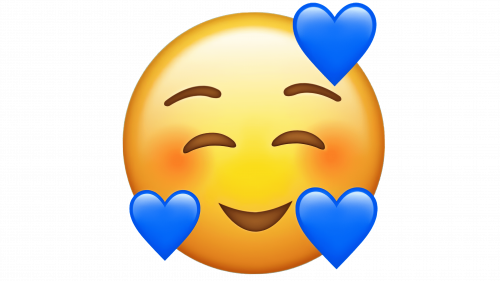The blue heart emoji, belonging to the realm of romantic symbols, has undergone an interesting evolution over the years. Having appeared in the digital world in 2010 in the Unicode 6.0 character set, it became entrenched in the Emoji 1.0 character set in 2015. Over time, its interpretation has undergone a number of changes to reflect the different perceptions of its vast user base.
Initially, the emoji had the noble purpose of being a beacon in support of autism. Over the years, however, its relevance in this role has diminished somewhat. Despite this, however, its deep associations with hope, faith, and aspiration remain unchanged.
Its hue, reminiscent of vast oceans and serene lakes, matches the refreshing essence of water. Therefore, it is not uncommon to find the blue heart emoji in conversations dedicated to beach vacations, water adventures, or even evoking the cold aura of windy landscapes.
If you think about it, the heart emblem harmonizes with the elemental characteristics of water. It evokes the vastness of the oceans, the pristine purity of freshwater springs, and the tranquility that these springs give. The blue heart becomes an emblem of depth, clarity, and peace – akin to moments of quiet contemplation.
By resonating with human relationships and feelings, the multifaceted blue heart offers a spectrum of meanings. Its neutral tone makes it a preferred choice for group communication, promoting a sense of unity without dipping into deep emotional waters. It has also carved a niche for itself as a symbol of platonic affection. Its presence in conversation between people, regardless of gender, is often a slight nod to camaraderie, avoiding romantic overtones. When this emblem appears in a message, the recipient can be assured of the sender’s trustworthiness.
If we delve into the ocean of interpretations, we can also consider an alternative point of view. For some, the “blue heart” causes melancholy or a somewhat dull mood. This association is rooted in the everyday use of the term “blue” to denote feelings of sadness. However, it is important to note that such feelings are not as deep or all-consuming as those symbolized by a rich black heart, often signifying deep sadness or desolation.
The connotations of the “blue heart” do not end there. Many see its more mature connotation as a subtle hint of deeper desires and intimate connections. In some contexts, its appearance may suggest that the sender yearns for a more personal, perhaps even physical, relationship outside of digital platforms.
Given the breadth and diversity of interpretations, caution is warranted. The meaning of an emoji can be deeply personal and differ from person to person. Therefore, to avoid potential misunderstandings, it is always wise to find out its meaning. After all, the “blue heart,” with its wide variety of meanings, adds depth and nuance to digital communications, making each interaction unique.
What does the blue heart emoji mean?
The Blue Heart emoji, a digital symbol recognized across multiple platforms, embodies a multitude of feelings, each driven by different interpretations of the color blue.
When one thinks of the vast expanse of the ocean, one immediately associates it with depth, vastness, and unchanging permanence. Similarly, the Blue Heart emoji conveys deep, unwavering, and unchanging love. Such sentiments are not limited to romantic relationships but often reflect the deep affection and bond shared in platonic relationships.
The color blue itself symbolizes several qualities and feelings. It is often associated with purity, reflecting the pristine nature of a cloudless sky. The purity of the color blue is reminiscent of a serene and pristine body of water, reflecting serenity and tranquility. In addition, blue is associated with feelings of sadness, emphasizing moments of introspection and melancholy. However, even in this gloomy atmosphere, there is hope for better times ahead.
In its digital simplicity, the Blue Heart emoji reflects the complexity of human emotions and relationships. Symbolizing deep love and affection, hope, clarity, and even desire, it remains one of the most popular means of expression in the digital age.





